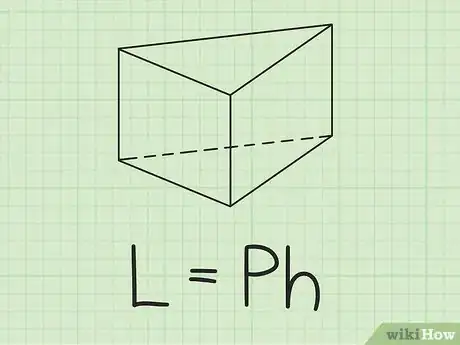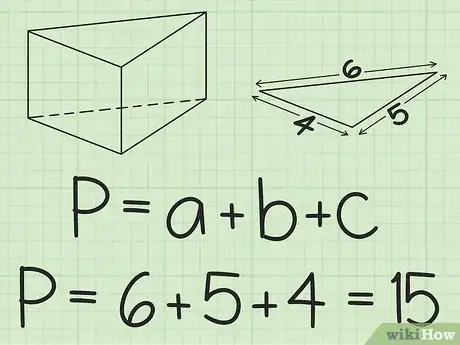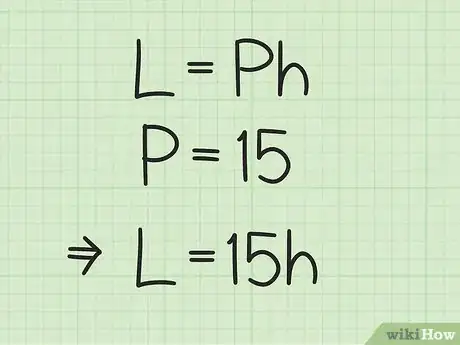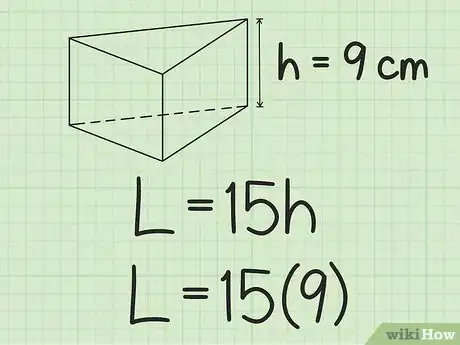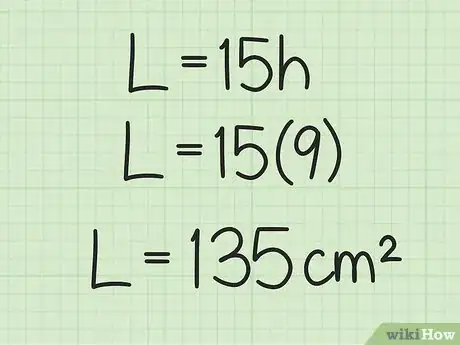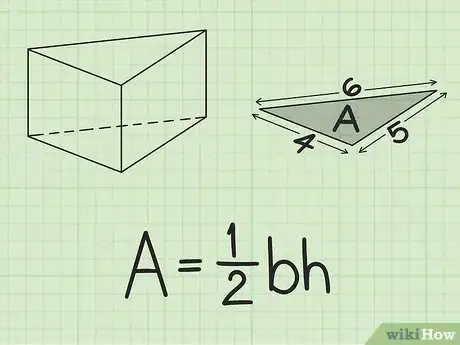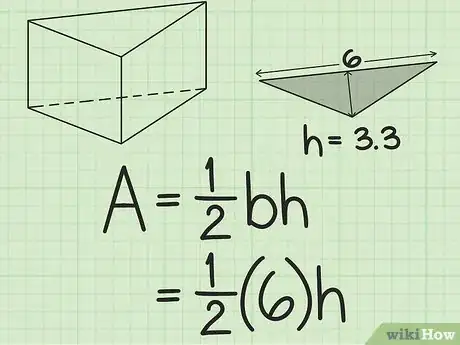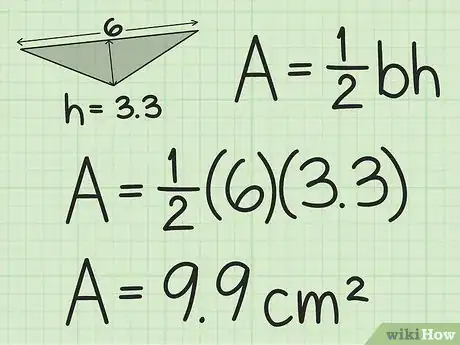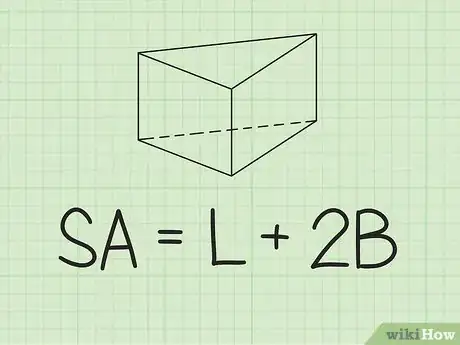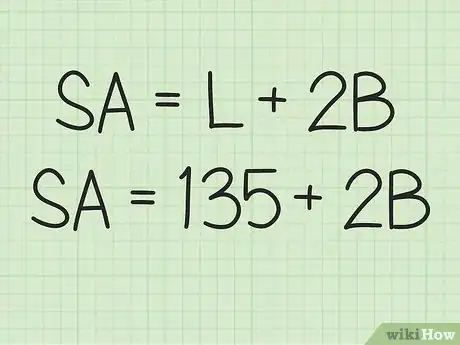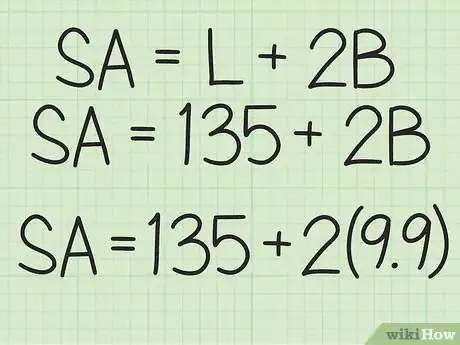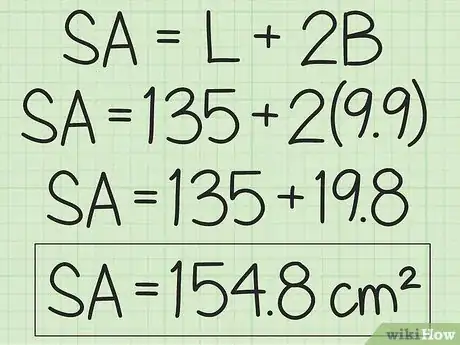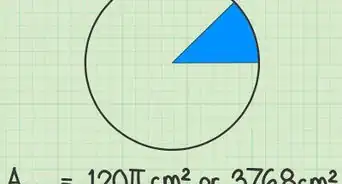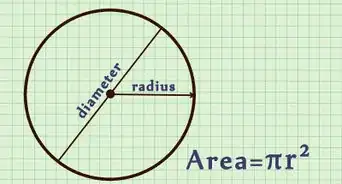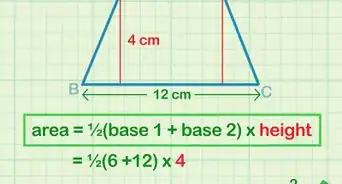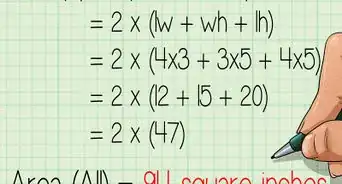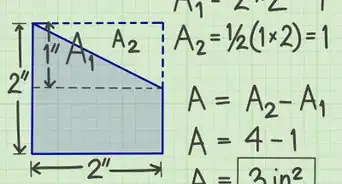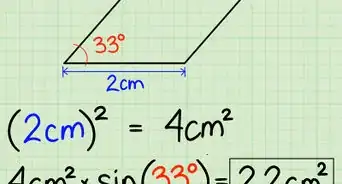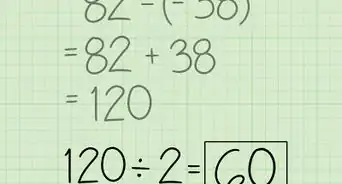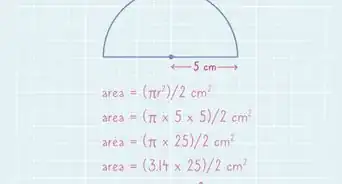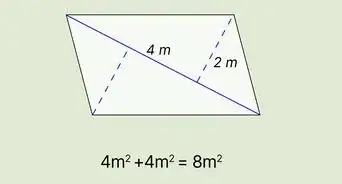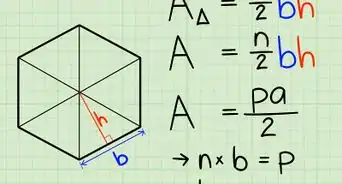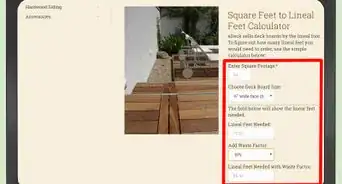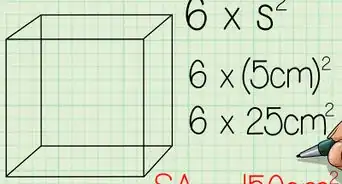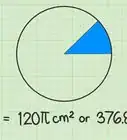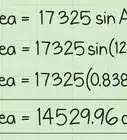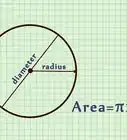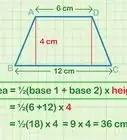This article was co-authored by wikiHow Staff. Our trained team of editors and researchers validate articles for accuracy and comprehensiveness. wikiHow's Content Management Team carefully monitors the work from our editorial staff to ensure that each article is backed by trusted research and meets our high quality standards.
There are 9 references cited in this article, which can be found at the bottom of the page.
This article has been viewed 321,485 times.
Learn more...
A prism is a three-dimensional shape with two parallel, congruent bases.[1] In a triangular prism, the bases are triangles. A triangular prism also has three lateral sides. To find the surface area of triangular prism, you first need to find the area of the lateral sides, then you need to find the area of the bases. Finally, you need to add these two areas together to find the total surface area. These steps are represented by the formula , where equals the lateral area of the prism and equals the area of one base.
Steps
Finding the Lateral Area
-
1Write down the formula for finding the lateral area of a triangular prism. The formula is , where equals the lateral area of the prism, equals the perimeter of one base, and equals the height of the prism.[2]
- The lateral area of a prism is the surface area of all sides, or faces, that are not the base.[3]
-
2Calculate the perimeter of one base. The base is a triangle, so it will have three sides. The area of the perimeter of a triangle is , where , , and are the length of each side of the triangle.[4] It doesn’t matter which base you use to calculate, because the two bases of a prism are congruent.
- For example, if the base has three sides measuring 6 cm, 5 cm, and 4 cm, to calculate the perimeter, you would add up all three sides: . So, the perimeter of one base is 15 cm.
Advertisement -
3Plug the perimeter into the lateral area formula. Make sure you substitute for the variable in the formula.
- For example, .
-
4Plug the height of the prism into the lateral area formula. The height of the prism is the same as the length of the side of any lateral face that is not connected to the base. Usually (but not always) this will be the longer side of the lateral face.
- For example, if the height of the prism is 9 cm, your formula will look like this: .
-
5Multiply the perimeter of one base with the height of the prism. The result will give you, in square units, the lateral surface area of the prism. This is the first value you need to find the total surface area of the prism, so set this value aside while you calculate the area of the base.[5]
- For example, , So, the lateral surface area of the prism is 135 square centimeters.
Finding the Area of the Base
-
1Set up the formula for the area of a triangle. Since the bases of a triangular prism are triangles, you will use this formula to calculate their area. The formula for the area of a triangle is , where equals the area of the triangle, equals the base of the triangle, and equals the height of the triangle.[6]
- This is the most common way to calculate the area of a triangle. If you don’t know the height of the triangle, you can also calculate the area using the length of the triangle’s three sides.
- You only need to find the area of one base, since the two bases of a prism are congruent, and will therefore have the same area.
-
2Plug the base of the triangle into the formula. Don’t confuse the base for another side of the triangle. The base is the side perpendicular to the height.[7]
- For example, if the base of the triangle is 6 cm, your formula will look like this: .
-
3Plug the height of the triangle into the formula. Multiply the base by the height. Then, take half of this value. This will give you the area of the base, in square units. This is the second value you need to calculate the total surface area of the prism.[8]
- For example, if the height is 3.3 cm, then your calculations will look like this:
So, the area of the base is 9.9 square centimeters.
- For example, if the height is 3.3 cm, then your calculations will look like this:
Finding the Surface Area
-
1Set up the formula for finding the surface area of a prism. The formula is , where equals the surface area of the prism, equals the lateral area of the prism, and equals the area of one base.
-
2Plug the lateral area into the formula. This is the surface area of all sides of the prism that are not the base. You should have calculated this previously. Make sure that you substitute the lateral area for the variable .[9]
- For example, if the lateral area of your triangular prism is 135 square centimeters, your formula will look like this: .
-
3Plug the area of one base into the formula. Make sure you use the area of just one base, not the total area of both bases combined. Substitute the base area for the variable .
- For example, if the area of one base of your prism is 9.9 square centimeters, your formula will look like this: .
-
4Complete the calculations. Multiply the area of the base by 2, then add the lateral area. This will give you the total surface area, in square units, of your triangular prism.
- For example:
So, the surface area of a triangular prism with a base having sides measuring 6, 5, and 4 centimeters in length, and a height measuring 9 centimeters in length, has a surface area of 154.8 square centimeters.
- For example:
Community Q&A
-
QuestionCan you make a clearer description of how to find the surface area of a triangular prism? I am so confused about how to do it, and I am freaked out that I will fail the test in school because of it!
 Community AnswerA triangular prism is just a box with triangles for the top and bottom. The walls of the box are the same as they are for any other box - rectangular. To find the surface area of the entire prism, you just find the surface area of the top, the bottom, and each wall - then you add them all together. So focus on each step on its own, as if it were its own problem, and write down the answer. What is the surface area of the triangular top? (Write that down.) What is the surface area of the triangular bottom? (Write that down.) Do the same for each wall, then add them all together. Then you're done! You'll find shortcuts along the way, but if they're confusing you now, don't worry about them.
Community AnswerA triangular prism is just a box with triangles for the top and bottom. The walls of the box are the same as they are for any other box - rectangular. To find the surface area of the entire prism, you just find the surface area of the top, the bottom, and each wall - then you add them all together. So focus on each step on its own, as if it were its own problem, and write down the answer. What is the surface area of the triangular top? (Write that down.) What is the surface area of the triangular bottom? (Write that down.) Do the same for each wall, then add them all together. Then you're done! You'll find shortcuts along the way, but if they're confusing you now, don't worry about them. -
QuestionHow can I find the surface area of the triangular prism without knowing its height?
 Community AnswerIt is not possible to find the surface area of a prism without knowing the height of the prism. If you are given the volume of the prism, it might be possible to derive the height from the formula V = bh, where V equals the volume, b equals the area of the base, and h equals the height. If you know the volume and the area of the base, you can solve for h. From here you can go on to calculate the surface area using the steps above.
Community AnswerIt is not possible to find the surface area of a prism without knowing the height of the prism. If you are given the volume of the prism, it might be possible to derive the height from the formula V = bh, where V equals the volume, b equals the area of the base, and h equals the height. If you know the volume and the area of the base, you can solve for h. From here you can go on to calculate the surface area using the steps above. -
QuestionI'm very confused on how to find the 2B, can you help?
 DonaganTop Answerer2B refers to the total area of the two triangular bases. As with any triangle, calculate the area of either triangular base by multiplying the "base" of the triangle (the length of one of its sides) by its height (the perpendicular distance from that side to the opposite vertex) and then dividing by 2. That gives you the area of either triangular base (B) of the prism. Multiply by 2 to get 2B, the total area of the two triangular bases. To that area you then add the "lateral" area (L) of the prism to get the total surface area (L + 2B).
DonaganTop Answerer2B refers to the total area of the two triangular bases. As with any triangle, calculate the area of either triangular base by multiplying the "base" of the triangle (the length of one of its sides) by its height (the perpendicular distance from that side to the opposite vertex) and then dividing by 2. That gives you the area of either triangular base (B) of the prism. Multiply by 2 to get 2B, the total area of the two triangular bases. To that area you then add the "lateral" area (L) of the prism to get the total surface area (L + 2B).
References
- ↑ http://www.mathopenref.com/prism.html
- ↑ http://www.virtualnerd.com/geometry/surface-area-volume-solid/prisms-cylinders-area/triangular-prism-lateral-surface-areas
- ↑ https://www.cuemath.com/measurement/lateral-area-of-triangular-prism/
- ↑ http://www.mathopenref.com/triangleperimeter.html
- ↑ https://virtualnerd.com/pre-algebra/perimeter-area-volume/surface-area/lateral-surface-areas-examples/triangular-prism-lateral-surface-areas
- ↑ http://www.mathwarehouse.com/geometry/triangles/area/index.php
- ↑ https://www.mathsisfun.com/algebra/trig-area-triangle-without-right-angle.html
- ↑ https://www.omnicalculator.com/math/triangle-area
- ↑ https://www.varsitytutors.com/hotmath/hotmath_help/topics/surface-area-of-a-prism
About This Article
To find the surface area of a triangular prism, use the formula Surface Area = L + 2B, where L is the lateral area and B is the area of the base. Find the lateral area by calculating the perimeter of the base and multiply it by the height of the prism. Then, find the base area by multiplying the base by the height of the triangle and dividing by 2. Next, plug the lateral area and base area into the Surface Area formula. Multiply the area of the base by 2 and add the lateral area to get your answer. Be sure to label your answer with the proper units squared. If you want to learn how to find the height of the base triangles, keep reading the article!



